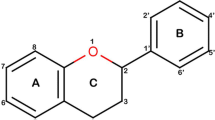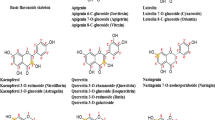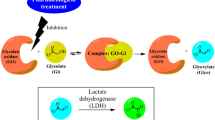Abstract
In this study, guinea pig aldehyde oxidase inhibitory activities of flavonoids were investigated using in silico, quantitative structure–activity relationships, molecular modeling, and experimental techniques, in order to understand more about their mode of interactions. The aldehyde oxidase inhibitory activity values determined experimentally in this work or collected from our previous report were used to derive mathematical models for the prediction purposes employing combined genetic algorithm and partial least square method, as well as multiple linear regression analysis. The statistical parameters for the developed models and the results of leave-one-out internal cross-validation were indicative of the validity of the models. To further investigate the mechanism of interaction between flavonoid inhibitors and guinea pig aldehyde oxidase enzyme, the structural model of the enzyme was built and the inhibitors were docked manually into the binding site. The model for quercetin-aldehyde oxidase complex was validated based on its appropriate stability during 10 ns molecular dynamics simulation, and hence the positioning procedure for the rest of flavonoids was guided based on the manually docked position of quercetin. The identified interactions were compared with those of flavonoids previously reported for rat aldehyde oxidase and the results showed a substantial commonality between the modes of interactions predicted for flavonoids positioned into the binding site of aldehyde oxidase from guinea pig and rat. This commonality is also reflected by the quantitative structure–activity relationships models. The results presented in this work may provide useful information where the structural requirements for aldehyde oxidase inhibition are sought, such as designing novel aldehyde oxidase inhibitors or investigating drug interaction involving aldehyde oxidase mediated biotransformation.








Similar content being viewed by others
References
Arnold K, Bordoli L, Kopp J, Schwede T (2006) The SWISS-MODEL workspace: a web-based environment for protein structure homology modelling. Bioinformatics 22(2):195–201
Baptista FI, Henriques AG, Silva AM, Wiltfang J, da Cruz e Silva OA (2014) Flavonoids as therapeutic compounds targeting key proteins involved in Alzheimer’s disease. ACS Chem Neurosci 5(2):83–92
Beedham C (1985) Molybdenum hydroxylases as drug-metabolizing enzymes. Drug Metab Rev 16(1-2):119–156
Beedham C (1987) Molybdenum hydroxylases: biological distribution and substrate-inhibitor specificity. Prog Med Chem 24:85–127
Beedham C, Critchley DJ, Rance DJ (1995) Substrate specificity of human liver aldehyde oxidase toward substituted quinazolines and phthalazines: a comparison with hepatic enzyme from guinea pig, rabbit, and baboon. Arch Biochem Biophys 319(2):481–490
Bharti S, Rani N, Krishnamurthy B, Arya DS (2014) Preclinical evidence for the pharmacological actions of naringin: a review. Planta Med 80(6):437–451
Bowie JU, Luthy R, Eisenberg D (1991) A method to identify protein sequences that fold into a known three-dimensional structure. Science 253(5016):164–170
Cerqueira NM, Coelho C, Bras NF, Fernandes PA, Garattini E, Terao M, Romao MJ, Ramos MJ (2015) Insights into the structural determinants of substrate specificity and activity in mouse aldehyde oxidases. J Biol Inorg Chem 20(2):209–217
Coelho C, Mahro M, Trincao J, Carvalho AT, Ramos MJ, Terao M, Garattini E, Leimkuhler S, Romao MJ (2012) The first mammalian aldehyde oxidase crystal structure: insights into substrate specificity. J Biol Chem 287(48):40690–40702
Consonni V, Todeschini R, Pavan M (2002) Structure/response correlations and similarity/diversity analysis by GETAWAY descriptors. 1. Theory of the novel 3D molecular descriptors. J Chem Inf Comput Sci 42(3):682–692
Darden T, York D, Pedersen L (1993) Particle mesh Ewald: an N·log(N) method for Ewald sums in large systems. J Chem Phys 98(12):10089–10092
Ferrazzano GF, Amato I, Ingenito A, Zarrelli A, Pinto G, Pollio A (2011) Plant polyphenols and their anti-cariogenic properties: a review. Molecules 16(2):1486–1507
Garattini E, Mendel R, Romao MJ, Wright R, Terao M (2003) Mammalian molybdo-flavoenzymes, an expanding family of proteins: structure, genetics, regulation, function and pathophysiology. Biochem J 372(Pt 1):15–32
Garattini E, Terao M (2012) The role of aldehyde oxidase in drug metabolism. Expert Opin Drug Metab Toxicol 8(4):487–503
Garattini E, Terao M (2013) Aldehyde oxidase and its importance in novel drug discovery: present and future challenges. Expert Opin Drug Discov 8(6):641–654
Ghaffari T, Nouri M, Saei AA, Rashidi MR (2012) Aldehyde and xanthine oxidase activities in tissues of streptozotocin-induced diabetic rats: effects of vitamin E and selenium supplementation. Biol Trace Elem Res 147(1-3):217–225
Gonzales GB, Smagghe G, Grootaert C, Zotti M, Raes K, Camp JV (2015) Flavonoid interactions during digestion, absorption, distribution and metabolism: a sequential structure-activity/property relationship-based approach in the study of bioavailability and bioactivity. Drug Metab Rev 47(2):175–190
Guex N, Peitsch MC (1997) SWISS-MODEL and the Swiss-Pdbviewer: an environment for comparative protein modeling. Electrophoresis 18(15):2714–2723
Hamzeh-Mivehroud M, Rahmani S, Feizi MA, Dastmalchi S, Rashidi MR (2014) In vitro and in silico studies to explore structural features of flavonoids for aldehyde oxidase inhibition. Arch Pharm 347(10):738–747
Hamzeh-Mivehroud M, Rahmani S, Rashidi MR, Hosseinpour Feizi MA, Dastmalchi S (2013) Structure-based investigation of rat aldehyde oxidase inhibition by flavonoids. Xenobiotica 43(8):661–670
Hansch C, Leo A, Hoekman DH (1995) Exploring QSAR: fundamentals and applications in chemistry and biology. American Chemical Society, Washington D.C
Hille R (2005) Molybdenum-containing hydroxylases. Arch Biochem Biophys 433(1):107–116
Hornak V, Abel R, Okur A, Strockbine B, Roitberg A, Simmerling C (2006) Comparison of multiple Amber force fields and development of improved protein backbone parameters. Proteins 65(3):712–725
Itoh K, Adachi M, Sato J, Shouji K, Fukiya K, Fujii K, Tanaka Y (2009) Effects of selenium deficiency on aldehyde oxidase 1 in rats. Biol Pharm Bull 32(2):190–194
Jordan CG, Rashidi MR, Laljee H, Clarke SE, Brown JE, Beedham C (1999) Aldehyde oxidase-catalysed oxidation of methotrexate in the liver of guinea-pig, rabbit and man. J Pharm Pharmacol 51(4):411–418
Kitamura S, Sugihara K, Ohta S (2006) Drug-metabolizing ability of molybdenum hydroxylases. Drug Metab Pharmacokinet 21(2):83–98
Kralj A, Nguyen M-T, Tschammer N, Ocampo N, Gesiotto Q, Heinrich MR, Phanstiel O (2013) development of flavonoid-based inverse agonists of the key signaling receptor us28 of human cytomegalovirus. J Med Chem 56(12):5019–5032
Kundu TK, Hille R, Velayutham M, Zweier JL (2007) Characterization of superoxide production from aldehyde oxidase: an important source of oxidants in biological tissues. Arch Biochem Biophys 460(1):113–121
Kurosaki M, Bolis M, Fratelli M, Barzago MM, Pattini L, Perretta G, Terao M, Garattini E (2013) Structure and evolution of vertebrate aldehyde oxidases: from gene duplication to gene suppression. Cell Mol Life Sci 70(10):1807–1830
Leardi R (2000) Application of genetic algorithm-PLS for feature selection in spectral data sets. J Chemometrics 14(5-6):643–655
Leardi R, González AL (1998) Genetic algorithms applied to feature selection in PLS regression: how and when to use them. Chemometr Intell Lab 41(2):195–207
Lecumberri E, Dupertuis YM, Miralbell R, Pichard C (2013) Green tea polyphenol epigallocatechin-3-gallate (EGCG) as adjuvant in cancer therapy. Clin Nutr 32(6):894–903
Liu HL, Jiang WB, Xie MX (2010) Flavonoids: recent advances as anticancer drugs. Recent Pat Anticancer Drug Discov 5(2):152–164
Luthy R, Bowie JU, Eisenberg D (1992) Assessment of protein models with three-dimensional profiles. Nature 356(6364):83–85
Magee PJ, Rowland I (2012) Soy products in the management of breast cancer. Curr Opin Clin Nutr Metab Care 15(6):586–591
Melo F, Feytmans E (1997) Novel knowledge-based mean force potential at atomic level. J Mol Biol 267(1):207–222
Melo F, Feytmans E (1998) Assessing protein structures with a non-local atomic interaction energy. J Mol Biol 277(5):1141–1152
Milbury PE (2012) Flavonoid intake and eye health. J Nutr Gerontol Geriatr 31(3):254–268
Obach RS, Huynh P, Allen MC, Beedham C (2004) Human liver aldehyde oxidase: inhibition by 239 drugs. J Clin Pharmacol 44(1):7–19
Park CY, Weaver CM (2012) Vitamin D interactions with soy isoflavones on bone after menopause: a review. Nutrients 4(11):1610–1621
Pirouzpanah S, Hanaee J, Razavieh SV, Rashidi MR (2009) Inhibitory effects of flavonoids on aldehyde oxidase activity. J Enzyme Inhib Med Chem 24(1):14–21
Rashidi MR, Beedham C, Smith JS, Davaran S (2007) In vitro study of 6-mercaptopurine oxidation catalysed by aldehyde oxidase and xanthine oxidase. Drug Metab Pharmacokinet 22(4):299–306
Rashidi MR, Nazemiyeh H (2010) Inhibitory effects of flavonoids on molybdenum hydroxylases activity. Expert Opin Drug Metab Toxicol 6(2):133–152
Rashidi MR, Smith JA, Clarke SE, Beedham C (1997) In vitro oxidation of famciclovir and 6-deoxypenciclovir by aldehyde oxidase from human, guinea pig, rabbit, and rat liver. Drug Metab Dispos 25(7):805–813
Rendeiro C, Guerreiro JD, Williams CM, Spencer JP (2012) Flavonoids as modulators of memory and learning: molecular interactions resulting in behavioural effects. Proc Nutr Soc 71(2):246–262
Ribeiro D, Freitas M, Lima JL, Fernandes E (2015) Proinflammatory pathways: the modulation by flavonoids. Med Res Rev 35(5):877–936
Ronda L, Bruno S, Bettati S, Storici P, Mozzarelli A (2015) From protein structure to function via single crystal optical spectroscopy. Front Mol Biosci 2:12
Roohbakhsh A, Parhiz H, Soltani F, Rezaee R, Iranshahi M (2014) Neuropharmacological properties and pharmacokinetics of the citrus flavonoids hesperidin and hesperetin--a mini-review. Life Sci 113(1-2):1–6
Roohbakhsh A, Parhiz H, Soltani F, Rezaee R, Iranshahi M (2015) Molecular mechanisms behind the biological effects of hesperidin and hesperetin for the prevention of cancer and cardiovascular diseases. Life Sci 124:64–74
Sahi J, Khan KK, Black CB (2008) Aldehyde oxidase activity and inhibition in hepatocytes and cytosolic fractions from mouse, rat, monkey and human. Drug Metab Lett 2(3):176–183
Sankari SL, Babu NA, Rani V, Priyadharsini C, Masthan KM (2014) Flavonoids - clinical effects and applications in dentistry: a review. J Pharm Bioallied Sci 6(Suppl 1):S26–S29
Sanoh S, Tayama Y, Sugihara K, Kitamura S, Ohta S (2015) Significance of aldehyde oxidase during drug development: effects on drug metabolism, pharmacokinetics, toxicity, and efficacy. Drug Metab Pharmacokinet 30(1):52–63
Schuur JH, Selzer P, Gasteiger J (1996) The coding of the three-dimensional structure of molecules by molecular transforms and its application to structure-spectra correlations and studies of biological activity. J Chem Inf Comput Sci 36(2):334–344
Soni M, Rahardjo TB, Soekardi R, Sulistyowati Y, Lestariningsih, Yesufu-Udechuku A, Irsan A, Hogervorst E (2014) Phytoestrogens and cognitive function: a review. Maturitas 77(3):209–220
Sorouraddin M-H, Amini K, Naseri A, Rashidi M-R (2010) Simultaneous spectrophotometric determination of phenanthridine, phenanthridinone and phenanthridine N-oxide using multivariate calibration methods. Cent Euro J Chem 8:207–213
Sorouraddin MH, Fooladi E, Naseri A, Rashidi MR (2008) A novel spectrophotometric method for determination of kinetic constants of aldehyde oxidase using multivariate calibration method. J Biochem Biophys Methods 70(6):999–1005
Srinivas NR (2015) Biochanin a: understanding the complexities in the paradoxical drug-drug interaction potential. Eur J Drug Metab Pharmacokinet 40(2):119–125
Tanaka T, Takahashi R (2013) Flavonoids and asthma. Nutrients 5(6):2128–2143
Tanveer A, Akram K, Farooq U, Hayat Z, Shafi A (2015) Management of diabetic complications through fruit flavonoids as a natural remedy. Crit Rev Food Sci Nutr [Epub ahead of print]
Testa B, Kramer SD (2007) The biochemistry of drug metabolism--an introduction: Part 2. Redox reactions and their enzymes. Chem Biodivers 4(3):257–405
Thompson JD, Higgins DG, Gibson TJ (1994) CLUSTAL W: improving the sensitivity of progressive multiple sequence alignment through sequence weighting, position-specific gap penalties and weight matrix choice. Nucleic Acids Res 22(22):4673–4680
Todeschini R, Gramatica P (1997) 3D-modelling and prediction by WHIM descriptors. Part 5. Theory development and chemical meaning of WHIM descriptors. Quant Struct Act Relat 16:113–116
Toukmaji A, Sagui C, Board J, Darden T (2000) Efficient particle-mesh Ewald based approach to fixed and induced dipolar interactions. J Chem Phys 113(24):10913–10927
Turner NA, Doyle WA, Ventom AM, Bray RC (1995) Properties of rabbit liver aldehyde oxidase and the relationship of the enzyme to xanthine oxidase and dehydrogenase. Eur J Biochem 232(2):646–657
Valentova K, Vrba J, Bancirova M, Ulrichova J, Kren V (2014) Isoquercitrin: pharmacology, toxicology, and metabolism. Food Chem Toxicol 68:267–282
Wenzel U (2013) Flavonoids as drugs at the small intestinal level. Curr Opin Pharmacol 13(6):864–868
Wootton JC, Nicolson RE, Cock JM, Walters DE, Burke JF, Doyle WA, Bray RC (1991) Enzymes depending on the pterin molybdenum cofactor: sequence families, spectroscopic properties of molybdenum and possible cofactor-binding domains. Biochim Biophys Acta 1057(2):157–185
Acknowledgments
The authors would like to thank Biotechnology Research Center, and School of Pharmacy at Tabriz University of Medical Sciences, for providing computational and experimental facilities.
Author information
Authors and Affiliations
Corresponding author
Ethics declarations
Conflict of interest
The authors declare that they have no conflict of interest.
Rights and permissions
About this article
Cite this article
Hamzeh-Mivehroud, M., Rahmani, S., Rashidi, MR. et al. Structural features of guinea pig aldehyde oxidase inhibitory activities of flavonoids explored using QSAR and molecular modeling studies. Med Chem Res 25, 2773–2786 (2016). https://doi.org/10.1007/s00044-016-1696-6
Received:
Accepted:
Published:
Issue Date:
DOI: https://doi.org/10.1007/s00044-016-1696-6




